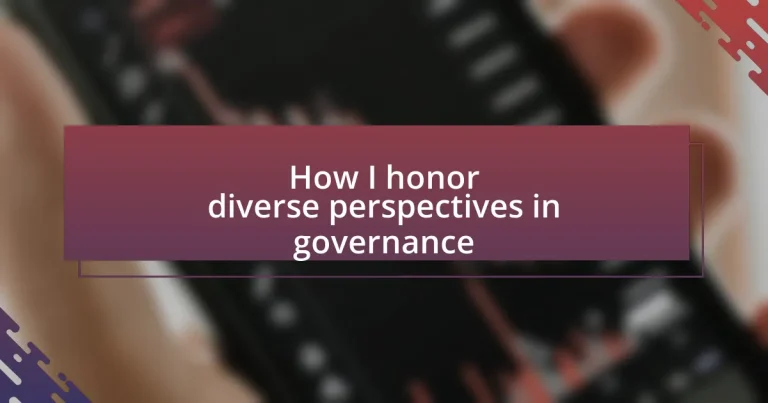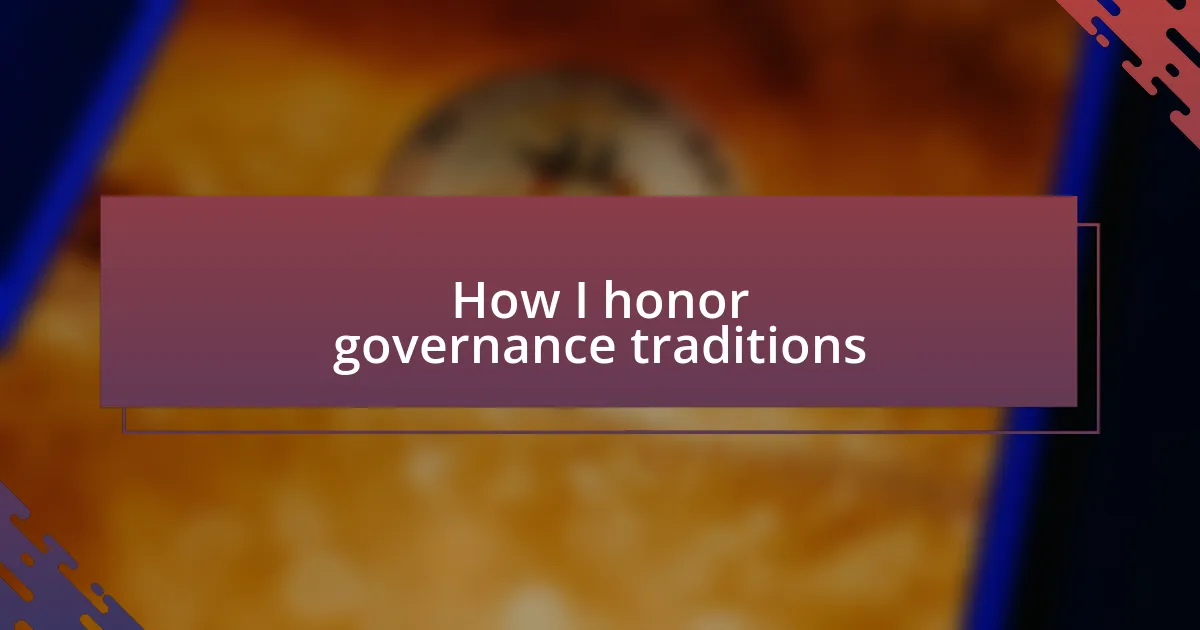Key takeaways:
- Understanding diverse perspectives in governance is essential for creating effective and inclusive policies that reflect community needs.
- Strategies for fostering diverse voices include creating dedicated platforms for dialogue, utilizing technology for outreach, and cultural competency training for officials.
- Engaging stakeholders through collaborative workshops, focus groups, and continuous feedback mechanisms enhances policy development and community trust.
- Successful case studies highlight the benefits of including underrepresented voices, leading to improved outcomes in various governance contexts.
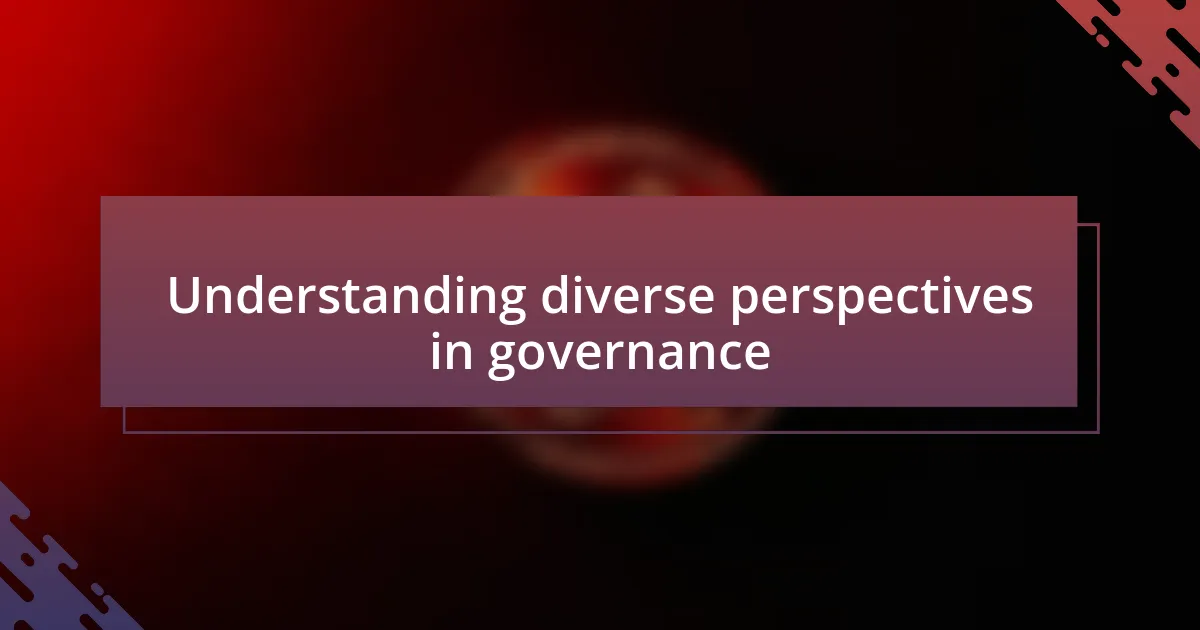
Understanding diverse perspectives in governance
Understanding diverse perspectives in governance is crucial for creating policies that genuinely resonate with the community. I remember attending a local forum where residents from various backgrounds shared their unique experiences with city policies. Listening to their stories highlighted how different cultural and socioeconomic contexts shape people’s needs and expectations in governance.
One striking example comes to mind: a fellow attendee shared how a lack of safe public spaces affected her community’s well-being. It made me wonder how often we overlook these real-life implications when making decisions in governance. It became clear that ignoring diverse perspectives not only alienates certain groups but can also lead to ineffective policies that fail to address underlying issues.
Embracing diversity means actively seeking out voices that are often marginalized. I often think about how my own background shapes my views and the importance of acknowledging that others have different realities. This recognition can lead to a more inclusive approach, ensuring that all community members feel represented and valued in the decision-making process.
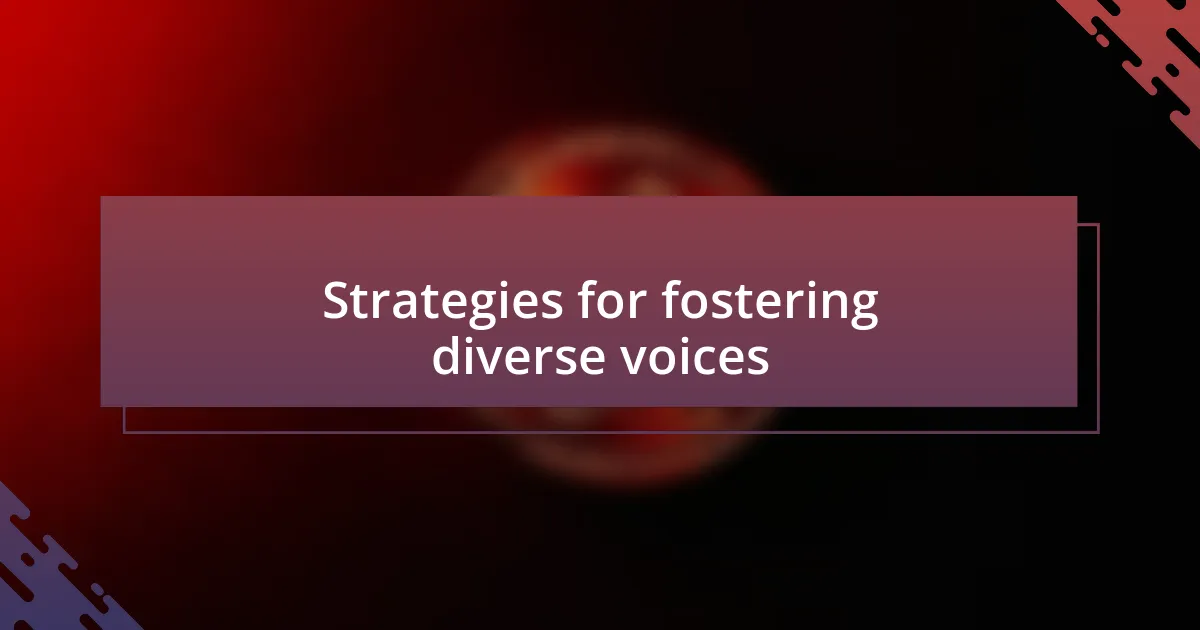
Strategies for fostering diverse voices
To foster diverse voices in governance, one effective strategy is to create dedicated platforms for dialogue. I once participated in a community advisory board where residents could voice their concerns directly to local leaders. The atmosphere was electric, as different viewpoints emerged, showcasing the rich tapestry of experiences that often goes unheard. Encouraging regular town hall meetings or community workshops can similarly empower individuals to share their stories and influence policy.
Another approach involves utilizing technology to broaden outreach. By actively engaging through social media and online surveys, I have seen how diverse groups can express their opinions in a comfortable environment. This digital accessibility not only creates a bridge for those who may be hesitant to speak in person but also allows for a broader array of voices to be heard in shaping decisions that affect their lives.
Additionally, training programs focused on cultural competency can significantly enhance the inclusivity of governance. I recall a workshop aimed at local officials, where we examined biases and learned to appreciate different cultural lenses. This experience underscored the importance of understanding communities on a deeper level, promoting empathetic governance that truly reflects the diversity of its constituents.
| Strategy | Description |
|---|---|
| Dedicated Platforms | Regular town hall meetings and advisory boards to encourage dialogue. |
| Utilizing Technology | Leveraging social media and online surveys for broader outreach. |
| Cultural Competency Training | Programs for officials to understand and appreciate diverse perspectives. |
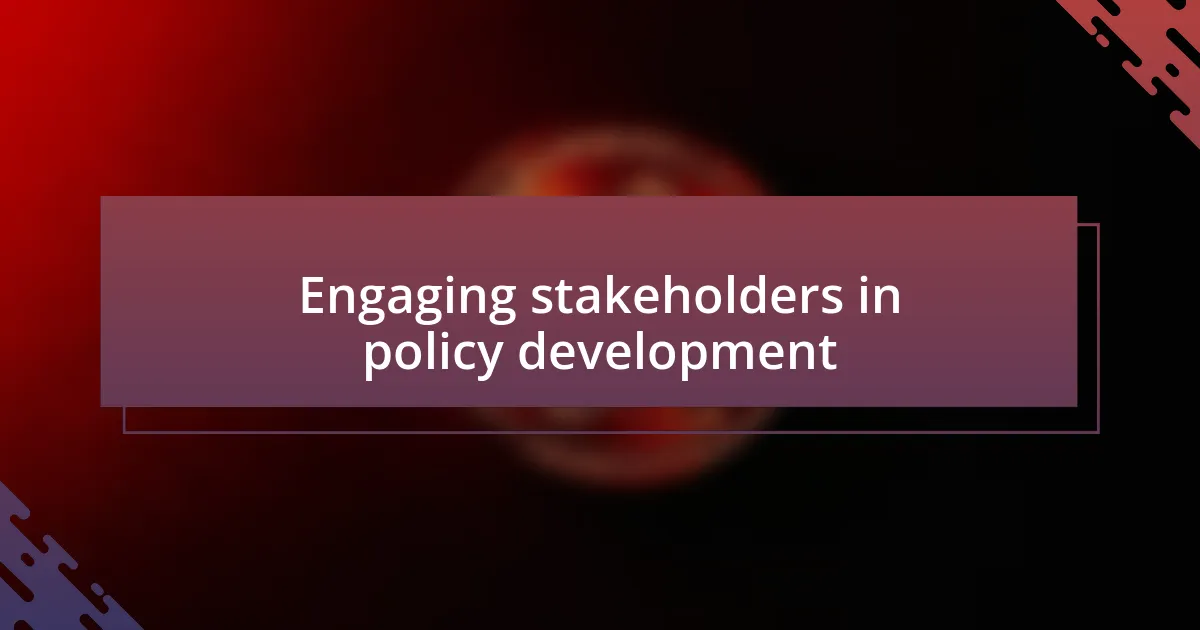
Engaging stakeholders in policy development
Engaging stakeholders in policy development is crucial for creating effective and inclusive governance. I vividly remember a project where our team invited representatives from marginalized communities to provide input on local housing policies. Their passionate stories about the struggles they faced opened my eyes to issues I had never considered before. It was clear that including their voices not only enriched the policy but also fostered trust between the community and local leaders.
To enhance engagement with stakeholders, it can be beneficial to implement the following strategies:
- Collaborative Workshops: Facilitate interactive sessions where stakeholders can co-create solutions, ensuring their insights shape the direction of policies.
- Focus Groups: Organize smaller, targeted discussions with key stakeholder groups to dive deeper into specific issues affecting their communities.
- Feedback Mechanisms: Establish clear channels for stakeholders to provide ongoing feedback on policies, keeping the dialogue open even after initial development stages.
- Partnerships with Local Organizations: Collaborate with community groups to reach diverse stakeholders effectively, leveraging their trust and understanding of the community’s dynamics.
- Regular Updates and Transparency: Keep stakeholders informed about policy progress, showing them how their contributions have been implemented and valued.
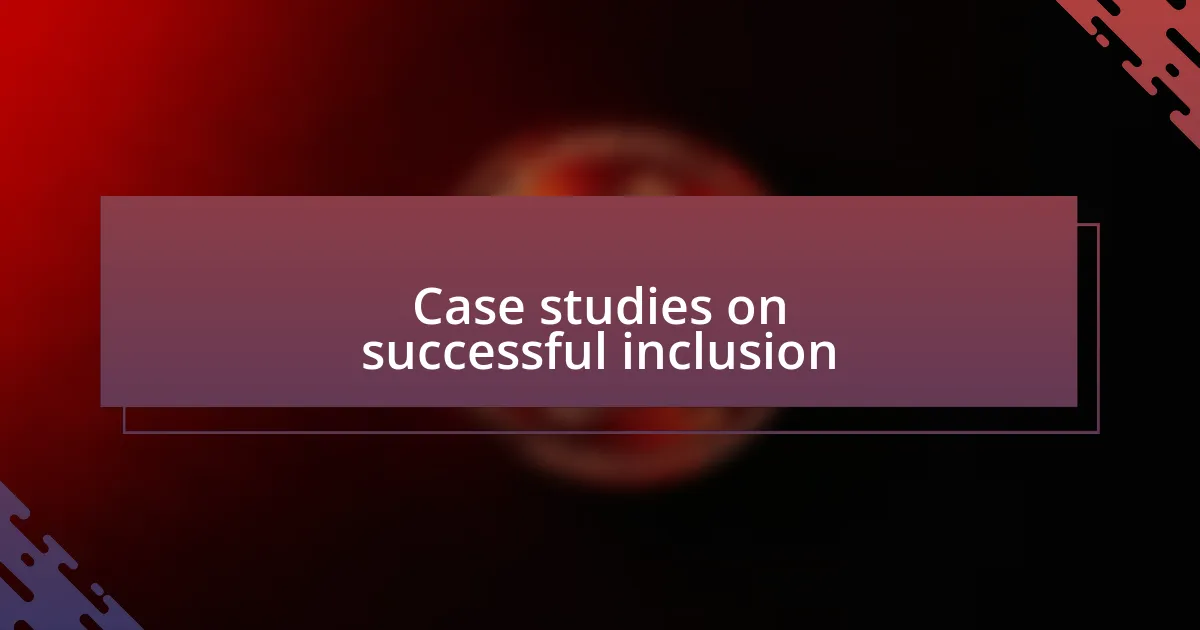
Case studies on successful inclusion
One compelling case study showcasing successful inclusion is a city council initiative in Canada that transformed its approach to community engagement. By establishing a diversity advisory committee, they elevated the voices of underrepresented groups. I recall attending one of their public sessions and feeling the palpable energy as participants shared their perspectives. What struck me was how participants, once hesitant, became more confident once they recognized their input was genuinely valued.
Another noteworthy example comes from a rural education reform project in South Africa. The government collaborated with local tribal leaders to understand the unique educational needs of their communities. During a visit, I witnessed the emotional resonance of the discussions; tribal leaders shared their histories and traditions, which provided essential context for tailoring curricula. This direct engagement not only led to improvements in educational outcomes but also built a sense of ownership within the community.
In yet another instance, a European public health campaign focused on immigrant populations demonstrated the importance of culturally sensitive strategies. Health authorities invited community ambassadors to help craft messaging that resonated with diverse backgrounds. I remember speaking with one ambassador who passionately described how their involvement bridged gaps of mistrust and misinformation. It was a powerful reminder that when diverse perspectives are honored, policies become more effective and communities become healthier.
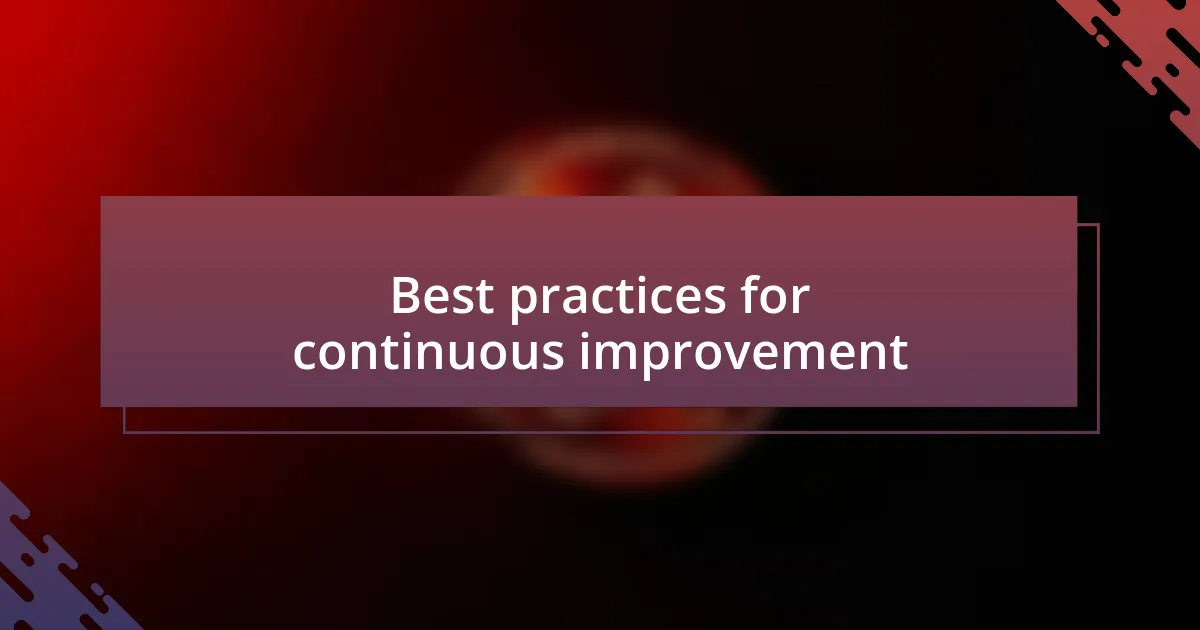
Best practices for continuous improvement
Continuous improvement in governance requires a commitment to feedback loops. When I think about how impactful it is to gather continuous input from community members, I recall a local town hall meeting I attended. The officials not only invited comments but actively sought suggestions on policy adjustments, fostering an environment where ideas could flow freely. This simple act transformed the meeting from a one-sided presentation into a collaborative brainstorming session.
Another valuable practice involves providing training sessions focused on cultural competency for all stakeholders in governance. In my experience, such initiatives can dismantle biases and broaden understanding among decision-makers. I vividly remember a workshop where a facilitator guided us through real-life scenarios that challenged our perspectives. It was eye-opening to share our reactions and learn how different cultural backgrounds influence our approaches to governance.
Lastly, celebrating small wins is crucial for maintaining motivation and momentum. I’ve often noticed that when teams acknowledge progress, no matter how minor, it boosts morale and encourages ongoing participation. During a quarterly review in one organization, the leaders made it a point to highlight the contributions of various community voices, instilling a sense of pride and reinforcing the idea that every perspective matters in the larger governance picture. Have you ever felt that surge of motivation when your efforts are recognized? It’s a powerful driver for continued engagement.

